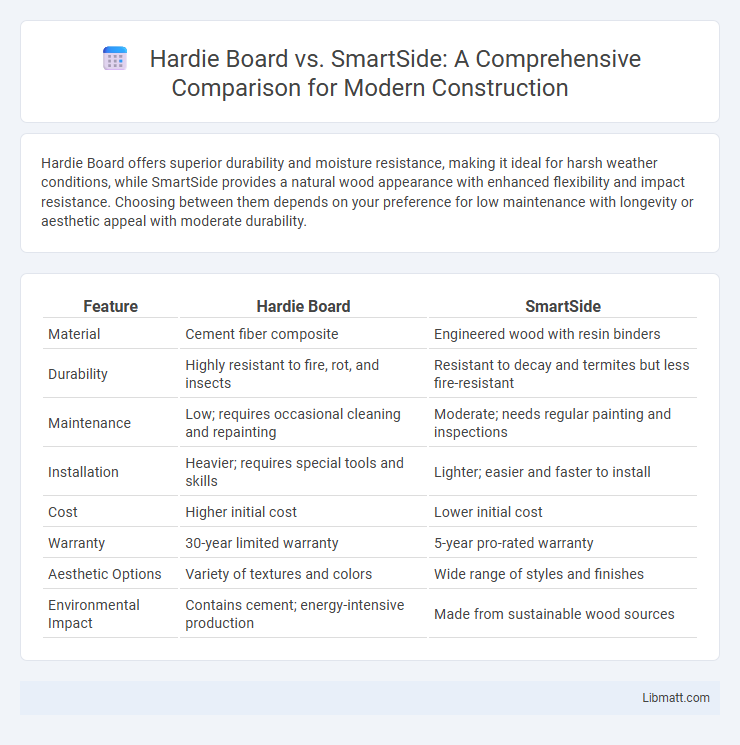Hardie Board offers superior durability and moisture resistance, making it ideal for harsh weather conditions, while SmartSide provides a natural wood appearance with enhanced flexibility and impact resistance. Choosing between them depends on your preference for low maintenance with longevity or aesthetic appeal with moderate durability.
Table of Comparison
| Feature | Hardie Board | SmartSide |
|---|---|---|
| Material | Cement fiber composite | Engineered wood with resin binders |
| Durability | Highly resistant to fire, rot, and insects | Resistant to decay and termites but less fire-resistant |
| Maintenance | Low; requires occasional cleaning and repainting | Moderate; needs regular painting and inspections |
| Installation | Heavier; requires special tools and skills | Lighter; easier and faster to install |
| Cost | Higher initial cost | Lower initial cost |
| Warranty | 30-year limited warranty | 5-year pro-rated warranty |
| Aesthetic Options | Variety of textures and colors | Wide range of styles and finishes |
| Environmental Impact | Contains cement; energy-intensive production | Made from sustainable wood sources |
Introduction to Hardie Board and SmartSide
Hardie Board is a fiber cement siding known for its durability, resistance to fire, and low maintenance requirements, making it a popular choice for long-lasting exterior cladding. SmartSide is a wood composite siding that offers enhanced strength and moisture resistance through zinc borate treatment, providing a natural wood appearance with improved durability. Both materials are engineered to withstand harsh weather conditions while delivering distinct aesthetic and performance benefits for residential and commercial buildings.
Material Composition and Manufacturing
Hardie board is made from fiber cement, combining cellulose fibers, cement, and sand to create a durable, fire-resistant siding with high moisture resistance. SmartSide consists of engineered wood strands coated with resin and zinc borate, providing enhanced impact resistance and protection against fungal decay. Your choice depends on whether you prioritize the robust, non-combustible nature of fiber cement or the lighter, flexible benefits of treated engineered wood.
Durability and Weather Resistance
Hardie board offers superior durability with its fiber-cement composition, making it highly resistant to fire, rot, and insect damage, which enhances its weather resistance in extreme climates. SmartSide siding, made from engineered wood and treated with proprietary SmartGuard technology, delivers excellent impact resistance and flexibility, effectively repelling moisture and reducing the risk of mold and termites. Your choice between the two should consider Hardie board's long-term, low-maintenance strength versus SmartSide's balance of cost-effectiveness and resilience against harsh weather conditions.
Installation Process and Requirements
Hardie board installation requires cutting fiber cement panels with a diamond blade, using corrosion-resistant nails, and maintaining consistent spacing for expansion and ventilation. SmartSide panels, made from engineered wood, can be cut with standard woodworking tools and installed with common nails, offering faster handling and reduced labor time. Both materials need moisture barriers and proper flashing, but SmartSide generally demands less specialized equipment and experienced labor than Hardie board.
Maintenance and Longevity
Hardie board, made from fiber cement, offers exceptional durability with resistance to rot, fire, and pests, requiring minimal maintenance such as occasional cleaning and repainting every 10-15 years. SmartSide siding features engineered wood treated with a proprietary SmartGuard process, providing good resistance to impact and moisture but demands more frequent maintenance including repainting every 5-7 years and inspections for potential damage. Both materials contribute to long-lasting exteriors, but Hardie board's superior resistance to harsh elements generally results in lower upkeep and a longer lifespan, often exceeding 50 years.
Aesthetic Options and Customization
Hardie board offers a wide range of colors and textures, including smooth, stucco, and wood grain finishes, allowing homeowners to achieve a highly personalized exterior look with long-lasting durability. SmartSide provides a more natural wood appearance with options for cedar, cedar shingle, and clapboard styles, and can be painted in various colors to match architectural preferences. Both materials support repainting and custom trims, but Hardie board's fiber cement composition gives it superior resistance to weathering while maintaining aesthetic versatility.
Cost Comparison and Value
Hardie Board typically costs more upfront than SmartSide, reflecting its fiber cement composition and superior durability against weather, fire, and pests. SmartSide offers a more budget-friendly option with wood composite materials, providing decent weather resistance but requiring more maintenance over time. Your choice should balance initial cost savings with long-term value, as Hardie Board's longevity often reduces replacement and repair expenses down the line.
Eco-Friendliness and Sustainability
Hardie Board is composed primarily of cement, sand, and cellulose fibers, making it resistant to fire, rot, and pests while being non-toxic and highly recyclable, contributing to its eco-friendliness. SmartSide siding, made from engineered wood products treated with zinc borate, offers a renewable resource base but requires chemical preservatives that may impact environmental sustainability. Both options provide durable, long-lasting materials that reduce the need for frequent replacements, but Hardie Board's lower environmental impact and higher recyclability give it an advantage in sustainable siding choices.
Warranty and Customer Support
Hardie Board offers a limited lifetime warranty that covers issues such as cracking, rotting, and termite damage, providing long-lasting protection backed by James Hardie's strong customer support network. SmartSide comes with a 5/50-year limited warranty, covering material defects and siding damage, with additional corrosion protection on nails, supported by LP's responsive customer service team. Your choice between these siding products should consider the warranty length and the quality of customer support to ensure peace of mind for your home investment.
Which Siding is Best for Your Home?
Hardie Board offers fiber cement durability, fire resistance, and low maintenance, making it ideal for homeowners seeking long-lasting protection and a classic appearance. SmartSide, constructed from engineered wood, provides superior impact resistance, easier installation, and enhanced flexibility in design options to suit your style preferences. Choosing between the two depends on your priorities for resilience, aesthetics, and budget to determine which siding best complements your home's needs.
Hardie board vs SmartSide Infographic

 libmatt.com
libmatt.com